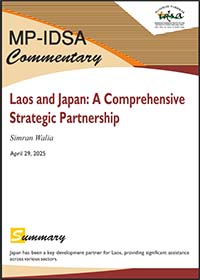Laos and Japan: A Comprehensive Strategic Partnership
- April 29, 2025 |
- IDSA Comments
Laos and Japan have developed a deep and multifaceted relationship. Both countries signed a Comprehensive Strategic Partnership (CSP) in January 2025.[i] The upgrade reflects the rapidly improving bilateral ties between Japan and Laos, especially in the areas of economics and people-to-people ties. Previously in 2015, a ‘strategic partnership’ was signed to strengthen sociocultural, economic and security connections.
Key focus areas for the CSP are economic cooperation and development, trade agreements, technological collaboration, education, environmental sustainability, cultural exchange and global cooperation. The CSP will prioritise regular high-level dialogues between Japanese and Laotian leaders. This will enhance mutual trust and ensure that both countries have a consistent and predictable framework for diplomatic engagement. Both nations also reaffirmed their commitment to collaborating in regional and international forums such as the ASEAN–Japan Framework, Mekong–Japan Cooperation and the United Nations (UN).
On 5 March 2025, the two nations marked the 70th anniversary of their diplomatic relations. Lao Prime Minister Sonexay Siphandone and Japanese Prime Minister Shigeru Ishiba exchanged greetings on the occasion.[ii] The two prime ministers promised to keep “deepening and expanding multi-layered exchanges”, which include people-to-people interactions, commerce, investment, economic cooperation and politics.
Japan has been a key development partner for Laos, providing significant assistance across various sectors to improve the country’s infrastructure, economy and social welfare. The assistance is typically offered through Official Development Aid (ODA) investment in infrastructure projects, technical cooperation and humanitarian assistance. Japan has given Lao People’s Democratic Republic a substantial amount of ODA, averaging between US$ 90 million and US$ 100 million every year since 1958, when Japan started providing assistance to Laos.[iii]
The Japanese government contributed nearly US$ 1.8 million in 2021 to support five programmes centred on oral health, education, vocational training and unexploded ordnance (UXO) clearance.[iv] UXO refers to munitions such as bombs, grenades, landmines or shells that did not detonate as intended during or after military operations and remain hazardous to people long after the conflict has ended.
Japan has been instrumental in funding and implementing key infrastructure projects in Laos. This includes the construction of roads, bridges and transportation networks. One of the most notable projects is the Asian Highway Network, which Japan has supported in Laos to improve regional connectivity.[v] With Laos being a major source of hydroelectric power in Southeast Asia, Japan has supported projects that help develop the country’s energy potential while promoting sustainable energy solutions.
Japan has also contributed to improving Laos’ railway network. The Laos–China railway, which began operations in December 2021, is one example of this cooperation. In October 2024, Japan committed up to 2.836 billion Japanese Yen to improve Vientiane International Airport. The project aims to expand the passenger terminal and renovate taxiways and aprons, enhancing convenience and safety to strengthen Laos’ connectivity.[vi]
Japan’s contribution to the reconstruction of King Anouvong Stadium, which honours the 70-year friendship, is among the most symbolic initiatives. In February 2024, Japan Infrastructure Partners (JIP) signed an agreement with the Japanese Ambassador to Laos for the construction of a submersible bridge in Laos. This project aims to improve accessibility in rural areas, particularly during the rainy season.[vii]
Regarding human resource development, Japan has funded various education programmes to enhance human capital in Laos. This includes sending Lao students to study in Japan and providing scholarships. The Japan International Cooperation Agency (JICA) has also implemented vocational training programmes to develop skills in various sectors such as agriculture, healthcare and technology. Japan agreed to help Laos’ educational system by providing funds to upgrade teacher training facilities. This project, which is anticipated to be completed by 2028 with a total expenditure of more than US$ 8.2 million, intends to promote educational standards.[viii]
Additionally, Japan has provided assistance to improve agricultural productivity in Laos, particularly in the rice and livestock sectors. This includes providing technical expertise, training farmers in modern techniques and introducing better agricultural practices to enhance food security. Japan has also been a strong advocate for sustainable development in Laos, particularly in protecting the country’s biodiversity. It has supported various programmes aimed at protecting forests, managing water resources and promoting eco-friendly policies.
One of the most recent efforts involves a grant of US$ 67,900 for a clean water supply project in Xieng Khouang Province, as part of an agreement reached on 25 February 2025. The project, which will be carried out in Xong Village, Phoukoud District, under Japan’s Grant Assistance for Grassroots Human Security Projects (GGP), would guarantee that locals have access to sanitised and clean water. The project intends to lower home drinking water costs while enhancing general living conditions by building a new water supply facility.
Moving Forward
These initiatives reflect Japan’s ongoing commitment to supporting Laos’ development across multiple sectors, fostering a robust and enduring partnership between the two nations. Through the Asian Development Bank, which is funded by Japan, as well as bilateral ODA, Japan has been a longstanding infrastructure development partner in Southeast Asia for many years. But in the past decade, China’s quick progress in this region has allowed it to overtake Japan in terms of Southeast Asia’s overall infrastructure development funding. In Cambodia, Indonesia, Laos and Malaysia, China has significantly surpassed Japan.[ix]
However, strengthening the relationship between Laos and Japan can help in building an international rules-based order. Japan can help Laos improve its legal institutions, capacity to implement international agreements and adherence to international conventions—especially in areas like human rights, environmental protection and trade. Laos has a diplomatic voice in promoting regional norms and regulations in Southeast Asia and beyond because it is an ASEAN member.
China is currently the largest investor in Laos, followed by Thailand, Vietnam, France and Japan. It is also the country’s second-largest trading partner after Thailand, despite Japan’s robust and ongoing economic involvement in Southeast Asia. The Boten–Vientiane railway, which has been in operation since 2021, is an example of how China has aided Laos’s infrastructure development and connectivity, increasing people-to-people interactions and bilateral trade.
Given these current dynamics, Laos and Japan elevated their ties to a comprehensive strategic partnership. While Japan is already an important trading partner for Laos, the CSP will provide a framework to expand trade further. By eliminating tariffs on key exports like agricultural products (e.g., rice, coffee and rubber), minerals and handicrafts from Laos, and high-tech products and machinery from Japan, the CSP can create a more conducive environment for increased trade.[x]
Laos’ accession to ASEAN in 1997 led to the implementation of ASEAN Free Trade Area (AFTA), which systematically reduced import tariffs, fostering increased trade within the region. Japan could export high-quality industrial products, technology and machinery to Laos, while Laos could export more agricultural products and natural resources to Japan. This partnership could further deepen Japan’s investments in areas like transportation networks, energy infrastructure and urban development. The CSP could include more extensive economic development initiatives, including promoting small and medium-sized enterprises (SMEs), enhancing human resource development and offering training programmes in information technology and management.[xi]
As seen by Laos’ growing economic reliance on China, small nations like Laos are frequently vulnerable to the influence of great powers. By enabling Laos to retain a certain amount of strategic autonomy and avoiding alignment with groups that oppose the current international order, Japan’s socioeconomic development assistance can give Laos a way to diversify the risk of becoming overly dependent on China. In addition, Japan could continue to support Laos’ participation in multilateral forums like UN and ASEAN, helping to integrate Laos more effectively into regional decision-making processes.
Japan’s diplomatic efforts in Southeast Asia aim to balance China by fortifying its economic and defence connections, improving regional security and lessening its reliance on the United States for security and trade by establishing itself as a more proactive security partner. For Laos, its partnership with Japan has brought significant benefits in terms of infrastructure development and technological advancement. For Japan, it has contributed to increasing its broader regional influence.
Views expressed are of the author and do not necessarily reflect the views of the Manohar Parrikar IDSA or of the Government of India.
[i] “Laos, Japan Elevate Ties to ‘Comprehensive Strategic Partnership’”, Asia News Network, 23 January 2025.
[ii] “Lao, Japanese PMs Hail 70th Anniversary Diplomatic Ties”, The Star, 5 March 2025.
[iii] “Laos-Japan Celebrate 70 Years of Diplomatic Relations”, Lao News Agency, 23 January 2025.
[iv] “Japan Grants Over USD 1.8 m to Support UXO Clearance, Education, Other Projects in Laos”, Lao News Agency, 4 March 2021.
[v] Liqin Wang, “China–Japan Competition in Infrastructure Investment in Southeast Asia: A Two-Level Analysis”, Chinese Political Science Review, 11 October 2022.
[vi] “Signing of Grant Agreement with Lao People’s Democratic Republic:Contributing to Strengthening the Industrial Base and Connectivity with Neighbouring Countries through Improvement of Vientiane International Airport”, Japan International Cooperation Agency (JICA), 31 October 2024.
[vii] “Agreement Signed with the Japanese Ambassador to Laos for the Construction of a Submersible Bridge in Laos”, Japan Infrastructure Partners, 17 February 2024.
[viii] “Signing of Grant Agreement with Lao People’s Democratic Republic Contributing to Improvement of the Quality of Education through the Construction of the Provincial Teacher Development Centers in 9 Provinces”, JICA, 26 February 2025.
[ix] Shay Wester, “Balancing Act: Assessing China’s Growing Economic Influence in ASEAN”, Asia Society Policy Institute, 8 November 2023.
[x] Sinthavanh Chanthavong, “Quantifying the Impact of Trade Liberalization on Lao Imports (Evidence from Product-level Data)”, International Journal of Economic Policy Studies, 2 September 2024.
[xi] “Small and Medium Enterprise Unit”, Japan Finance Corporation.





